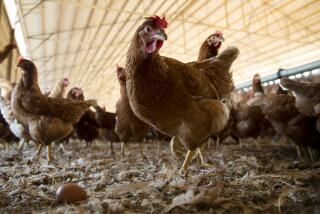Bee colony collapse viruses spreading to bumblebees
- Share via
Infectious diseases linked to the colony collapse of honeybees appear to be spreading among wild bumblebees that pollinate crops worldwide, dealing a potential double blow to agriculture, according to a new study.
Studies at 26 sites in England found that 1 in 5 bees suffered from deformed wing virus, which can ground and eventually kill the insects, according to a report published online Wednesday in the journal Nature.
More than a third of the honeybees were infected, and about 11% of the bumblebees carried the virus – figures that researchers called highly conservative. Evidence of another deadly parasite, the Nocema ceranae microspore, was less prevalent.
Although the path of the infection could not be determined with certainty, researchers said it very likely spreads from the honeybees, 88% of which carried actively replicating virus. Foraging from the same flowers probably accounts for the bulk of infection, while raiding of competitors’ hives could contribute as well, the researchers said.
“We’re only catching individuals that are alive and healthy and able to go out and forage,” said principal author Mark J.F. Brown, a conservation biologist at the Royal Holloway University of London. “It’s likely that the prevalence numbers that we report are lower than they actually are.”
Commercially cultivated bees pollinate about 90 crops worldwide, a service valued at $14 billion annually. In California, the $3-billion almond industry spends $239 million annually to rent more than 1 million honeybee colonies.
Researchers suspect the Varroa destructor mite that infests honeybees is the primary transporter of the viruses. The sites in England are not unique hot spots, they added, but represent an outbreak pattern that could occur anywhere managed colonies of honeybees come in contact with native pollinators.
“If our interpretation of the direction of flow of the pathogen is correct, the prerequisites for that to be true are true across North America, across Europe and pretty much anywhere where honeybees have very high levels of the virus due to this parasitic mite Varroa destructor,” Brown said.
The results drive home the need to manage honeybee colonies with greater care and to increase efforts to eradicate the Varroa mite, researchers said.
“We need as clean honeybee hives as possible, so the spread into the environment is mitigated,” said coauthor Matthias A. Furst, an evolutionary ecologist at Holloway University.
Although major crops, such as almonds in California, depend heavily on domestic colonies of honeybees, a study last year showed that wild pollinators frequently account for as much or more of the successful pollination of crops, even where farmers import commercial hives.
“Wild bees are contributing a substantial and significant fraction of the pollination services that we require,” Brown said. “Honeybees are absolutely important, but so are wild bees.”
Indeed, efforts to support native pollinators could be subverted by infected honeybees foraging in the same area, the researchers suggest. “If you’re going to try to reintroduce extinct bumblebee populations to a site, it would be very sensible to assess the managed honeybees near that site,” Brown said.
“I think the important take-home message is that we need to be concerned not just about our managed pollinators, but our wild pollinators as well.”
Pathogens such as the virus causing wing deformation are not the only factors linked to colony collapse, which is most prevalent in North America. Research highlights a combination of pesticide use, management practices and a variety of pathogens, including Israeli acute paralysis virus. A study last month showed that an additional virus that causes blight on soy crops has leaped from plants to honeybees.
Another study last year fund 35 pesticides, some at lethal levels, in the pollen collected from bees servicing major food crops in five states, including California. Use of pesticides has been linked to compromised immune systems that leave bees more susceptible to disease.






